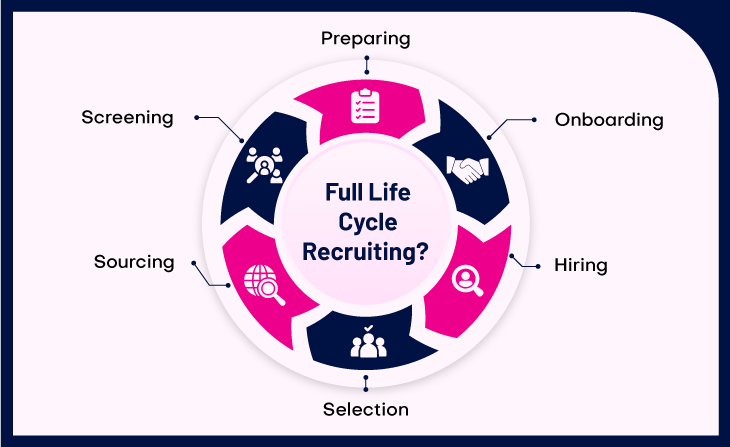Topics: 360 Recruitment, Full Cycle Recruitment, Recruitment Outsourcing
Posted on September 16, 2024
Written By Aanchal Jain

The recruitment industry is facing unprecedented challenges due to an on-going talent shortage. Traditional, intuition-based recruitment methods often fall short, leading to mismatches, hiring biases, and costly inefficiencies. To counter these issues, many organizations are turning to the 360 recruitment process—a comprehensive, data-driven approach that transforms how businesses attract and retain top talent.
This end-to-end recruitment methodology ensures that every stage, from sourcing to onboarding, is handled seamlessly. By adopting the 360 recruitment process, businesses can make informed hiring decisions, reduce costs, and build high-performing teams that align with their long-term goals..
A 360 recruitment process, also referred to as full-cycle or end-to-end recruitment, encompasses the entire hiring journey. It’s a comprehensive approach where a single recruiter takes ownership of all aspects of finding and securing the ideal candidate for a specific role. From the initial identification of a talent gap to the successful onboarding of the new hire, a 360 degree recruitment specialist manages every step of the recruitment cycle.
Usually, a full cycle recruiter is responsible for completing all stages of a recruitment life cycle. Large organizations may have separate teams, HR professionals, or departments to take care of different stages of a full cycle recruitment process. Outsourced full cycle recruitment services or its specific stages such as candidate sourcing, screening, onboarding, etc., is a common practice for staffing firms having huge volumes of hiring requirements.
Take a closer look at the different stages of full life cycle recruiting below to understand how you can optimize the 360 recruitment process.

The first stage of the 360 recruitment process is all about preparation and planning for hiring. This involves identifying a talent gap in the organization and understanding the specific requirements for the role. The preparation stage includes:
Pro Tip: Ensure the job description highlights both technical skills and company values to appeal to candidates who align with your organization’s culture.
The second stage of the 360 recruitment process focuses on finding the right talent using various sourcing methods. Since many qualified candidates are passive job seekers, this step often requires a proactive approach:
Pro Tip: Invest in advanced sourcing tools like Applicant Tracking Systems (ATS) and Customer Relationship Management (CRM) systems to streamline sourcing efforts and manage candidate pipelines efficiently.
The screening stage is critical in shortlisting the most suitable candidates from the applicant pool. This step ensures that only qualified candidates move forward in the 360 recruitment process:
Pro Tip: Use pre-employment tests, such as cognitive ability or personality assessments, to predict job performance and avoid mismatches.
The selection stage involves detailed interviews and assessments to identify the best-fit candidate for the role. This stage is where the recruiter delves deeper into a candidate’s profile:
Pro Tip: Maintain open communication between recruiters and hiring managers during this stage. Regular updates help align on candidate preferences and make informed decisions.
This is the most sensitive phase of the 360 recruitment process, where the selected candidate is offered the role and negotiations take place:
Pro Tip: Provide constructive feedback to candidates who were not selected. This builds a positive employer brand and keeps unsuccessful candidates engaged for future opportunities.
Onboarding marks the final stage of the 360 recruitment process and is crucial for integrating new hires into the organization successfully:
Pro Tip: Create a structured onboarding checklist to ensure nothing is missed. Regular check-ins during the first few weeks help address any issues early and improve retention rates.
360 recruitment process or full cycle recruiting can help build a better relationship between the hiring manager and candidates and provide a good experience to everyone. The most efficient way to complete your hiring needs is to outsource full cycle recruiting to 360 recruitment consultants like QX Global Group. These end-to-end specialists will handle each phase of the full life cycle recruitment and offer major benefits in reducing hiring costs and time.
The 360 role in recruitment refers to a recruiter who handles every stage of the hiring process, from sourcing candidates to onboarding them, ensuring a seamless and efficient recruitment cycle.
The key components include preparation, sourcing, screening, selection, hiring, and onboarding. Each stage is designed to ensure a smooth and effective hiring experience for both the employer and candidate.
By leveraging advanced tools, structured interviews, and data-driven assessments, the 360 recruitment process ensures candidates are evaluated based on skills, experience, and cultural fit, minimizing mismatches.
The 360 process employs structured assessments, blind resume reviews, and diverse sourcing strategies, reducing unconscious bias and fostering a more inclusive hiring process.
Success can be measured through metrics like time-to-hire, cost-per-hire, employee retention rates, and candidate satisfaction scores.
CONNECT WITH A 360 RECRUITMENT CONSULTANT
We hope you enjoyed reading this blog. If you want our team to help you resolve talent gaps, reduce costs and transform your business operations, just book a call.
Originally published Sep 16, 2024 01:09:51, updated Aug 15 2025
Topics: 360 Recruitment, Full Cycle Recruitment, Recruitment Outsourcing